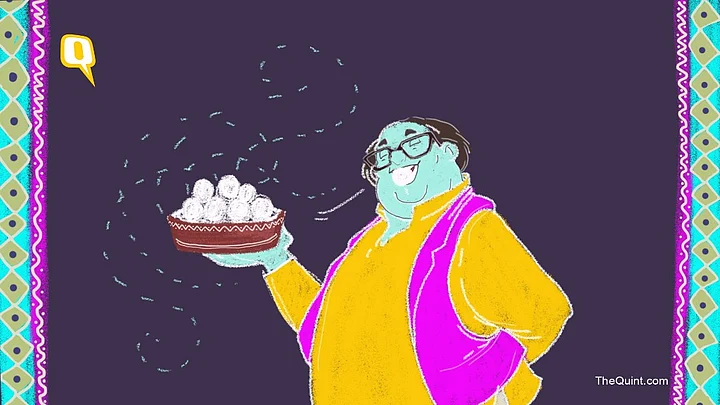There was a time when Bengali weddings – and the food porn that would follow in their wake – would not be quite complete if guests were not served rosogollas after an overwhelming feast. So, when several large sealed tins reached my sister’s Calcutta wedding venue in 1987, my father took charge of the stock.
He beamed in sheer happiness when one of the tins was cut open to reveal these small white, spongy balls, bobbing in a viscous, sickly sweet liquid.
And when dessert was served, the guests devoured the rosogollas as if there was no tomorrow. Not in ones or twos, but some popped in small mountains of the sweetmeat piled up on their banana leaf plates. Needless to say, the gorging was followed by unabashedly loud burps.
I later learnt that dad’s made-to-order rosogollas came from a certain factory in West Bengal’s Basirhat sub-division in North 24 Parganas district, and they truly melted in your mouth.
That was then.
Today, as Bengalis vainly rejoice in chauvinistic glee after the ‘Geographical Indication (GI)’ status that the rosogolla truly belongs to the state and not Odisha, they might as well be humming ‘Ami Kolkatar Rosogolla’, a third-rate song from a fourth-rate Bengali film Rakte Lekha (Written in Blood) (1992).
The GI’s ruling may be “written in stone”, but Bengalis must recall that a few years ago, scientific tests on ‘chhana’, the basic ingredient that is blown up into small balls – something in between the size of a ping pong and a tennis ball – to make steaming rosogollas, were found to be adulterated with high levels of acidic/toxic content.
But hey, thank the GI for its decision on the rosogolla, perhaps the middle-class Bengali’s last remaining item of pride when Tagore, the living legend, has already slipped out of her grasp, as Bangladesh’s hugely talented Rabindreeks (those who have mastered ‘Rabindrasangeet’ beyond challenge) continue to revere the great bard beyond the commercial returns.
The Curious Journey of the Rosogolla
There was just one Tagore, but he remains torn between claimants in the western and eastern parts of what was one Bengal. Would the West Bengal Chief Minister Mamata Banerjee move GI to lay claim to “kabi guru” Tagore, lyrically the sweetest bard ever, and who transcends borders and boundaries?
And yet there are many forms – and therefore tastes – of the rosogolla: in white, in kesari, in pink and, more recently, even in chocolate.
The more traditional white ones, which, today, don’t melt on your tongue upon touch, spongy as they are, were supposedly “introduced” in present day West Bengal by Baghbazar-based confectioner Nobin Chandra Das (the father of KC Das) in 1868.
But legend has it that Das’ invention was preceded by the master confectioners who, along with the cooks, tended the kitchen of Puri’s Lord Jagannath. Das, it is said, only popularised the rosogolla, while a man named Braja Moira beat him to the invention in 1866, when he started selling the sweet from a thatched-roof shop near the Calcutta High Court.
Yet another account of 1906 says that the rosogolla was the invention of Haradhan Moira of Phulia, who was employed by the Pal Choudhury zamindari household of Ranaghat.
The rosogolla had competition too – from other imaginatively named variants such as “jatingolla” and “bhabanigolla”. And yet, it took a 19th century Shekhawati timber merchant Bhagwandas Bagla to popularise the sweet by buying huge quantities of it from Das’s Baghbazar store.
Whatever the truth, the time of folklore and legend has long passed. West Bengal, under Mamata Banerjee, can’t afford to expend its energies on just a sweetmeat when the state’s economy is down and out, the state’s much tom-tommed culture only an ugly caricature of its once glorious past.
The Bengal vs Odisha War
Bengal has won the GI tag on rosogolla, but will it be able to create the conditions for deepening and preserving the fame and taste that is attached with it? Or will indolence get the better of Bengalis in ways that would degrade the rosogolla as they have their ‘kaalchaar’?
Over the years, Bengalis have been derisive, if not downright insulting, of Odiyas, sniggering at them as people worthy only as cooks. And yet, it is Odisha and its hardworking people who have pipped Bengal and Bengalis – in educational attainments, in competitive examinations, in businesses, and I dare say, in most other critical social indicators.
(Breathe In, Breathe Out: Are you finding it tough to breathe polluted air? Join hands with FIT to find #PollutionKaSolution. Send in your suggestions to fit@thequint.com or WhatsApp @ +919999008335)
(At The Quint, we question everything. Play an active role in shaping our journalism by becoming a member today.)
